神经网络pid本科学位论文
本科毕业论文PID温控系统的设计及仿真

CENTRAL SOUTH UNIVERSITY 本科生毕业论文题目PID温控系统的设计及仿真学生指导教师学院信息科学与工程学院专业班级完成时间年月摘要温度是工业控制的主要被控参数之一。
可是由于温度自身的一些特点,如惯性大,滞后现象严重,难以建立精确的数学模型等,给控制过程带来了难题。
要对温度进行控制,有很多方案可选。
PID 控制简单且容易实现,在大多数情况下能满足性能要求。
模糊控制的鲁棒性好,无需知道被控对象的数学模型,且在快速性方面有着自己的优势。
研究分析了PID 控制和模糊控制的优缺点,把两者相互结合,采用了用模糊规则整定P K 、I K 两个参数的模糊自整定PID 控制方法。
本研究以电烤箱为控制对象,用MATLAB 软件对PID 控制、模糊控制和参数模糊自整定PID 控制的控制性能分别进行了仿真研究。
仿真结果表明PID 对于对象模型复杂和模型难以确定的控制系统具有很大的局限性,不能满足调节时间短、超调小的技术要求。
由于模糊控制的理论(如量化因子和比例因子的确定问题)并不完善,其可能获得的控制性能无法把握,而且模糊控制易受模糊规则有限等级的限制而引起稳态误差。
参数模糊自整定PID 控制吸收前两种方法的长处,满足了调节时间短、超调量为零且稳态误差较小的控制要求。
因此本论文最终确定采用参数模糊自整定PID 控制方案。
本系统硬件采用了以 AT89C52 单片机为核心的温度控制器,选用 k 型热电偶为温度传感器结合MAX6675芯片构成前向通道,同时双向晶闸管和SSR 构成后向通道,由按键、LED 数码显示器及报警单元等组成人机联系电路。
关键词:单片机,PID ,模糊控制,仿真ABSTRACTTemperature is one of the main parameters in the industrial process control.Yetthere are difficultiesto have a good control oftemperature becauseof the characteristics of the temperature itself:the temperature inertia is great, its time-lag is serious and it is hardto establish an accurate mathematical model.There are many methods to be selected in order to control a system. The PID controlis simple,easily realized andin most casesit meetsthe control demand. Fuzzy control has the advantage of quickness,itsrobustness is good and there is no needto know theobject ’smathematical model.This paper analyses the advantages and disadvantages of both PID control and fuzzycontrol and es to the method of bining them together,fuzzy self-tuningPID control. In this method,P K and I K of the PID controller are adjusted by fuzzy control rules .In the paper simulations of PID control, fuzzy control and fuzzyself-tuning PID control are done by MATLAB to control a electric oven.Conclusions are that for those control objects of which models are plicated or hard to establish,the PID method has limitation and doesn ’t meet the control demand. As the fuzzy control method theory is not perfect, a good control performance cannot be expected. And it could easily cause the steady-state error for it is restricted by limited grades of the fuzzy rules.Finally the fuzzy self-tuning PID control method is selected, since it meets the control demands.In this paper AT89C52 is used as controller, toward access is posed of K which is used as the temperature sensor and MAX6675.Backward access is posed of bidirectional thyristor and SSR. Man-machine circuit is posed of keyboard, LED and warning unit, etc.Key words :Micro Controller, PID Control, Fuzzy Control, Simulation目 录摘要IABSTRACTII第一章绪论11.1 课题的提出及意义11.2 控制系统背景介绍11.3 当代温控系统及智能算法2第二章温控系统的设计52.1 温控系统的总体设计52.1.1 温控系统设计的基本原则52.1.2 温控系统的结构及设计62.2 温控系统的硬件设计72.2.1 前向通道设计72.2.2 后向通道设计102.2.3 人机通道设计11小结15第三章系统控制方案163.1 PID 控制163.1.1 PID的概述163.1.2 PID 控制的基本理论及特点163.2 模糊控制183.2.1 模糊控制的概述183.2.2 模糊控制的基本原理及特点183.3 模糊PID 控制19小结21第四章仿真研究224.1 MATLAB及其模糊逻辑工具箱和仿真环境simulink224.2 仿真和优选234.2.1 控制对象模型234.2.2 仿真和方案选择25小结32第五章总结与展望335.1 主要工作容335.2 工作小结335.3 存在的问题及未来的方向34结束语35参考文献36第一章绪论1.1 课题的提出及意义温度是生产过程和科学实验中非常普遍而又十分重要的物理参数。
神经网络PID控制器的设计与仿真

*******大学毕业设计(论文) 题目神经网络PID控制器的设计与仿真院系专业班级学生姓名指导教师二○○八年六月神经网络PID控制器的设计与仿真摘要PID控制技术是一种应用很普遍的控制技术,目前在很多方面都有广泛的应用. 在工业控制中,PID控制是工业控制中最常用的方法。
这是因为PID控制器结构简单、实现简单,控制效果良好,已得到广泛应用。
据统计,在目前的控制系统中,PID控制占了绝大多数。
但是,他具有一定的局限性:当控制对象不同时,控制器的参数难以自动调整以适应外界环境的变化。
为了使控制器具有较好的自适应性,实现控制器参数的自动调整,可以采用神经网络控制的方法。
利用人工神经网络的自学习这一特性,并结合传统的PID控制理论,构造神经网络PID控制器,实现控制器参数的自动调整。
本论文讨论了基于神经网络的PID 控制,利用神经网络的自学习能力进行在线参数整定,并利用Matlab软件进行仿真。
通过仿真实现可以看出它具有自学习、自适应性等特点,网络的收敛速度快,能够对非线性对象有很好的控制,系统的跟踪性能很好.其参数设定无需知道被控对象的具体参数及其数学模型,对不同的对象具有适应性.关键词:PID控制神经网络Matlab 仿真The design and simulation of the neural networkPID controllerABSTRACTPID control technology is a very common control technology in many aspects of a wide range of applications. In industrial control, PID control is the most commonly used in industrial control methods. This is because the PID controller simple structure, to achieve a simple, effective control, has been widely used. According to statistics, PID control is the vast majority in the present control system. However, he has certain limitations: When the control object is not at the same time, the controller parameters to automatically adjust to the changes in the external environment. In order to make the controller has good adaptability, and Controller Parameters of automatic adjustments can be used neural network control method. Using artificial neural network learning oneself, combined with the traditional PID control theory Structure of neural networks PID controller, and implementate the automatic adjustment of controller parameters. The thesis discussed according to the neural network PID controller,and control,make use of the neural network from the study ability to proceed its function to on-line parameter amend,and make use ofthe Matlab software proceeds to imitatereally.By the simulation can see that it is to achieve self-learning, adaptability, and other characteristics ,network convergence speed, can have a good control on non-linear object ,and tracking of system performance very good. Its parameters need to know the object of the specific parameters and its mathematical model,and adapt different objects.KEY WORDS:PID control Neural network Matlab Simulation目录摘要 (I)ABSTRACT (II)1 绪论 (1)1.1 前言 (1)1.2 神经元网络PID的发展历程 (1)1.3 神经网络的特点 (2)1.4 神经网络的主要研究方向 (2)1.5 神经网络PID的发展现状和前景展望 (3)1.6 课题研究方法和内容 (3)2 神经网络控制理论 (4)2.1 神经网络的简介 (4)2.2 神经网络的基本概念 (4)2.3 神经网络控制的基本原理 (4)2.4 神经网络结构的分类 (5)2.5 神经网络的学习 (6)2.5.1 学习方式 (6)2.5.2 网络模型及其学习算法 (6)2.6 神经网络的训练 (7)3 应用MATLAB设计神经网络PID控制系统 (8)3.1 MATLAB、SIMULINK、神经网络工具箱简介 (8)3.2 神经网络工具箱与人工神经元网络设计 (9)3.3 PID控制器 (10)3.3.1 PID控制器简介 (10)3.3.2 PID控制的局限 (12)3.4 神经网络 PID 控制器的设计 (12)4 神经网络PID控制器的设计 (14)4.1 单神经元自适应PID控制器及其学习算法 (14)4.1.1 采用有监督Hebb学习算法的单神经元自适应PID控制器 (14)4.1.2 单神经元自适应PID控制器学习算法可调参数的选取规律 (16)4.1.3 单神经元自适应PID仿真 (16)4.2 基于BP神经网络PID控制器的设计 (18)4.3 小结 (21)5 结束语 (22)参考文献 (23)致谢 (24)1 绪论1.1 前言计算机技术的迅速发展,为计算机控制的发展和应用奠定了坚实的基础,过程计算机控制以自动控制理论和计算机技术为基础,实现了现代化生产过程的综合自动化,可使生产过程保持最佳运行状态,从而提高安全性、经济性和运行水平。
基于遗传算法的PID参数优化毕业设计(论文)

本科生毕业设计(论文)论文题目:基于遗传算法的PID参数优化毕业设计(论文)原创性声明和使用授权说明原创性声明本人郑重承诺:所呈交的毕业设计(论文),是我个人在指导教师的指导下进行的研究工作及取得的成果。
尽我所知,除文中特别加以标注和致谢的地方外,不包含其他人或组织已经发表或公布过的研究成果,也不包含我为获得及其它教育机构的学位或学历而使用过的材料。
对本研究提供过帮助和做出过贡献的个人或集体,均已在文中作了明确的说明并表示了谢意。
作者签名:日期:指导教师签名:日期:使用授权说明本人完全了解大学关于收集、保存、使用毕业设计(论文)的规定,即:按照学校要求提交毕业设计(论文)的印刷本和电子版本;学校有权保存毕业设计(论文)的印刷本和电子版,并提供目录检索与阅览服务;学校可以采用影印、缩印、数字化或其它复制手段保存论文;在不以赢利为目的前提下,学校可以公布论文的部分或全部内容。
作者签名:日期:学位论文原创性声明本人郑重声明:所呈交的论文是本人在导师的指导下独立进行研究所取得的研究成果。
除了文中特别加以标注引用的内容外,本论文不包含任何其他个人或集体已经发表或撰写的成果作品。
对本文的研究做出重要贡献的个人和集体,均已在文中以明确方式标明。
本人完全意识到本声明的法律后果由本人承担。
作者签名:日期:年月日学位论文版权使用授权书本学位论文作者完全了解学校有关保留、使用学位论文的规定,同意学校保留并向国家有关部门或机构送交论文的复印件和电子版,允许论文被查阅和借阅。
本人授权大学可以将本学位论文的全部或部分内容编入有关数据库进行检索,可以采用影印、缩印或扫描等复制手段保存和汇编本学位论文。
涉密论文按学校规定处理。
作者签名:日期:年月日导师签名:日期:年月日注意事项1.设计(论文)的内容包括:1)封面(按教务处制定的标准封面格式制作)2)原创性声明3)中文摘要(300字左右)、关键词4)外文摘要、关键词5)目次页(附件不统一编入)6)论文主体部分:引言(或绪论)、正文、结论7)参考文献8)致谢9)附录(对论文支持必要时)2.论文字数要求:理工类设计(论文)正文字数不少于1万字(不包括图纸、程序清单等),文科类论文正文字数不少于1.2万字。
神经网络优化PID参数论文
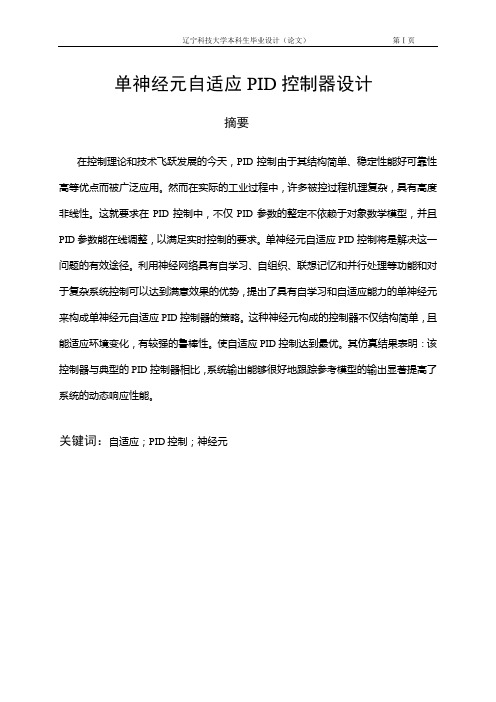
辽宁科技大学本科生毕业设计(论文)第Ⅰ页单神经元自适应PID控制器设计摘要在控制理论和技术飞跃发展的今天,PID控制由于其结构简单、稳定性能好可靠性高等优点而被广泛应用。
然而在实际的工业过程中,许多被控过程机理复杂,具有高度非线性。
这就要求在PID控制中,不仅PID参数的整定不依赖于对象数学模型,并且PID参数能在线调整,以满足实时控制的要求。
单神经元自适应PID控制将是解决这一问题的有效途径。
利用神经网络具有自学习、自组织、联想记忆和并行处理等功能和对于复杂系统控制可以达到满意效果的优势,提出了具有自学习和自适应能力的单神经元来构成单神经元自适应PID控制器的策略。
这种神经元构成的控制器不仅结构简单,且能适应环境变化,有较强的鲁棒性。
使自适应PID控制达到最优。
其仿真结果表明:该控制器与典型的PID控制器相比,系统输出能够很好地跟踪参考模型的输出显著提高了系统的动态响应性能。
关键词:自适应;PID控制;神经元Single Neuron Adaptive PID Controller DesignAbstractIn the rapid development of control theory and technology nowaday, PID control has been widely used because of its simple structure, stable performance and high reliability. However, in actual industrial processes, many complex mechanism controlled process has highly nonlinear.This requires the PID control, PID parameter setting not only do not rely on mathematical models, and the PID parameters can be adjusted on line to meet the requirements of real-time control. Single neuron adaptive PID control will be an effective way to solve this problem. Using neural network self-learning, self-organization, associative memory and parallel processing features and control of complex systems can achieve satisfactory results, this paper proposed a self-learning and adaptive capacity of single neurons to form the single neuron adaptive PID control strategy. These neurons constitute the controller not only simple in structure, and can adapt to environmental changes, have stronger robustness. Adaptive PID control to optimal. The simulation results show that the controller, compared with the typical PID controller, the system output can track the reference model very well, the output of the system significantly improved dynamic response.Keywords: adaptive, PID control, neurons目录摘要 (I)ABSTRACT ...................................................................................................................................... I I 1绪论 . (1)1.1自适应控制介绍 (1)1.2自适应控制系统的分类 (2)1.3自适应控制的理论 (4)2 PID控制 (7)2.1PID控制器 (7)2.2PID控制器的参数整定 (8)2.3自适应PID控制 (9)3 神经网络控制的发展与应用 (10)3.1传统控制理论的局限性 (10)3.2神经网络控制的发展与现状 (11)3.3人工神经网络与自动控制 (13)3.4单神经元模型 (13)3.5人工神经元的数学模型 (15)3.6激活函数 (16)3.7神经网络学习规则 (17)4单神经元自适应PID控制器的设计 (19)4.1单神经元自适应PID控制器 (19)4.2改进的单神经元自适应PID控制器 (20)4.3转换器的实现 (20)4.4常规PID控制器与单神经元自适应PID控制器仿真比较 (21)4.5单神经元自适应PID控制器学习规则可调参数的选取 (23)结论 (24)致谢 (25)参考文献 (26)附录A (27)附录B (28)1绪论1.1 自适应控制介绍70年代以来,由于空间技术和过程控制发展的需要,特别是在微电子和计算机技术的推动下,自适应发展很快[1]。
基于神经网络的模糊PID控制器设计与实现

基于神经网络的模糊PID控制器设计与实现随着科技的不断发展,控制技术在工业自动化中的应用越来越广泛。
PID控制器因其简单易懂、易实现的特点而被广泛使用,但是传统的PID控制器在某些场合下会出现失效的情况。
为了解决这一问题,研究者们开始着手开发基于神经网络的模糊PID控制器。
本文将介绍基于神经网络的模糊PID控制器的设计与实现。
一、控制器介绍基于神经网络的模糊PID控制器是一种新型的控制器,它将模糊控制的优点与神经网络的处理能力相结合,形成了一种高效的自适应控制器。
该控制器利用神经网络的学习算法实现自适应参数的调节,将模糊控制中的模糊规则与神经网络的处理能力相结合,形成一种新的控制方法。
该控制器的核心思想是利用神经网络对系统进行建模,通过学习算法自适应地调节系统参数,从而实现对系统的控制。
其中,模糊控制器用于对输出进行模糊处理,神经网络用于对输入和输出进行处理,从而实现对系统的控制。
二、控制器设计基于神经网络的模糊PID控制器的设计需要以下几个步骤:1.系统建模系统建模是设计基于神经网络的模糊PID控制器的第一步。
系统建模的目的是构建系统的数学模型,以便于后续的设计过程。
在建模过程中,需要考虑系统的类型、运动方程、非线性因素等因素。
2.控制器设计控制器的设计是基于神经网络的模糊PID控制器设计的核心。
控制器的设计包括神经网络的结构设计、神经网络权值的选择、模糊控制的设计等。
3.参数调节参数调节是控制器设计的重要环节。
由于系统的运动方程等因素的影响,不同系统的参数可能不同。
因此,在实际应用中需要根据实际情况对控制器进行参数调节。
三、控制器实现基于神经网络的模糊PID控制器的实现需要以下步骤:1.数据采集数据采集是基于神经网络的模糊PID控制器实现的第一步。
数据采集的目的是获取系统的输入输出,以便为神经网络提供数据。
2.神经网络训练神经网络训练是实现控制器的关键步骤。
在训练过程中,通过对神经网络进行学习,让它逐渐对系统的输入输出进行建模。
神经网络PID控制器的设计与仿真

*******大学毕业设计(论文) 题目神经网络PID控制器的设计与仿真院系专业班级学生指导教师二○○八年六月神经网络PID控制器的设计与仿真摘要PID控制技术是一种应用很普遍的控制技术,目前在很多方面都有广泛的应用. 在工业控制中,PID控制是工业控制中最常用的方法。
这是因为PID控制器结构简单、实现简单,控制效果良好,已得到广泛应用。
据统计,在目前的控制系统中,PID控制占了绝大多数。
但是,他具有一定的局限性:当控制对象不同时,控制器的参数难以自动调整以适应外界环境的变化。
为了使控制器具有较好的自适应性,实现控制器参数的自动调整,可以采用神经网络控制的方法。
利用人工神经网络的自学习这一特性,并结合传统的PID控制理论,构造神经网络PID控制器,实现控制器参数的自动调整。
本论文讨论了基于神经网络的PID控制,利用神经网络的自学习能力进行在线参数整定,并利用Matlab软件进行仿真。
通过仿真实现可以看出它具有自学习、自适应性等特点,网络的收敛速度快,能够对非线性对象有很好的控制,系统的跟踪性能很好.其参数设定无需知道被控对象的具体参数及其数学模型,对不同的对象具有适应性.关键词:PID控制神经网络Matlab 仿真The design and simulation of the neural network PID controllerABSTRACTPID control technology is a very common control technology in many aspects of a wide range of applications. In industrial control, PID control is the most commonly used in industrial control methods. This is because the PID controller simple structure, to achieve a simple, effective control, has been widely used. According to statistics, PID control is the vast majority in the present control system. However, he has certain limitations: When the control object is not at the same time, the controller parameters to automatically adjust to the changes in the external environment. In order to make the controller has good adaptability, and Controller Parameters of automatic adjustments can be used neural network control method. Using artificial neural network learning oneself, combined with the traditional PID control theory Structure of neural networks PID controller, and implementate the automatic adjustment of controller parameters. The thesis discussed according to the neural network PID controller,and control,make use of the neural network from the study ability to proceed its function to on-line parameter amend,and make use ofthe Matlab software proceeds to imitatereally.By the simulation can see that it is to achieve self-learning, adaptability, and other characteristics ,network convergence speed, can have a good control on non-linear object ,and tracking of system performance very good. Its parameters need to know the object of the specific parameters and itsmathematical model,and adapt different objects.KEY WORDS:PID control Neural network Matlab Simulation目录摘要 (I)ABSTRACT (II)1 绪论 (1)1.1 前言 (1)1.2 神经元网络PID的发展历程 (1)1.3 神经网络的特点 (2)1.4 神经网络的主要研究方向 (2)1.5 神经网络PID的发展现状和前景展望 (3)1.6 课题研究方法和容 (3)2 神经网络控制理论 (4)2.1 神经网络的简介 (4)2.2 神经网络的基本概念 (4)2.3 神经网络控制的基本原理 (4)2.4 神经网络结构的分类 (5)2.5 神经网络的学习 (6)2.5.1 学习方式 (6)2.5.2 网络模型及其学习算法 (6)2.6 神经网络的训练 (7)3 应用MATLAB设计神经网络PID控制系统 (8)3.1 MATLAB、SIMULINK、神经网络工具箱简介 (8)3.2 神经网络工具箱与人工神经元网络设计 (9)3.3 PID控制器 (10)3.3.1 PID控制器简介 (10)3.3.2 PID控制的局限 (12)3.4 神经网络PID 控制器的设计 (12)4 神经网络PID控制器的设计 (14)4.1 单神经元自适应PID控制器及其学习算法 (14)4.1.1 采用有监督Hebb学习算法的单神经元自适应PID控制器 (15)4.1.2 单神经元自适应PID控制器学习算法可调参数的选取规律 (16)4.1.3 单神经元自适应PID仿真 (17)4.2 基于BP神经网络PID控制器的设计 (19)4.3 小结 (23)5 结束语 (23)参考文献 (24)致谢 (25)1 绪论1.1 前言计算机技术的迅速发展,为计算机控制的发展和应用奠定了坚实的基础,过程计算机控制以自动控制理论和计算机技术为基础,实现了现代化生产过程的综合自动化,可使生产过程保持最佳运行状态,从而提高安全性、经济性和运行水平。
基于BP神经网络的PID控制器的研究与实现
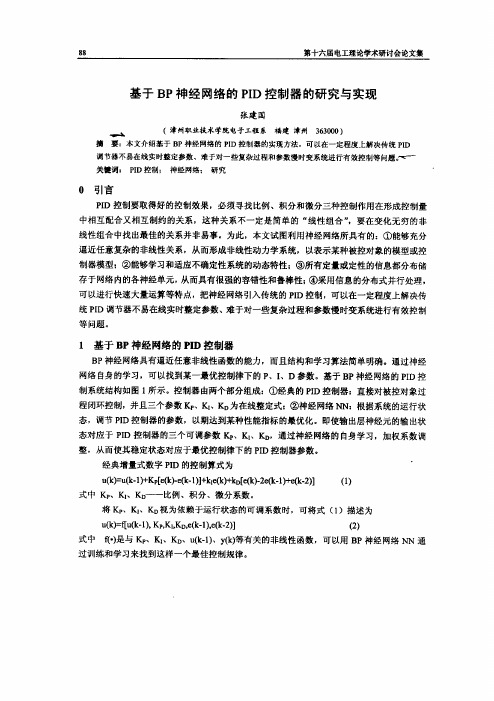
第十六届电工理论学术研讨会论文集基于BP神经网络的PID控制器的研究与实现张建国.(漳州职业技术学院电于工程系福建漳州363000)摘要:本文介绍基于BP神经网络的PID控制器的实现方法,可以在一定程度上解决传统PID调节器不易在线实时整定参数、难于对一些复杂过程和参数幔时变系统进行有效控制等问题。
一r一关键词:PID控制;神经网络;研究O引言PID控制要取得好的控制效果,必须寻找比例、积分和微分三种控制作用在形成控制量中相互配合又相互制约的关系,这种关系不一定是简单的“线性组合”,要在变化无穷的非线性组合中找出最佳的关系并非易事。
为此,本文试图利用神经网络所具有的:①能够充分逼近任意复杂的非线性关系,从而形成非线性动力学系统,以表示某种被控对象的模型或控制器模型;②能够学习和适应不确定性系统的动态特性;⑨所有定量或定性的信息都分布储存于网络内的各神经单元,从而具有很强的容错性和鲁棒性;④采用信息的分布式并行处理,可以进行快速大量运算等特点,把神经网络引入传统的PID控制,可以在一定程度上解决传统PID调节器不易在线实时整定参数、难于对一些复杂过程和参数慢时变系统进行有效控制等问题。
1基于BP神经网络的PID控制器BP神经网络具有逼近任意非线性函数的能力,而且结构和学习算法简单明确。
通过神经网络自身的学习,可以找到某一最优控制律下的P、I、D参数。
基于BP神经网络的PID控制系统结构如图1所示。
控制器由两个部分组成:①经典的PID控制器:直接对被控对象过程闭环控制,并且三个参数KP、KI、KD为在线整定式;②神经网络NN:根据系统的运行状态,调节PID控制器的参数,以期达到某种性能指标的最优化。
即使输出层神经元的输出状态对应于PID控制器的三个可调参数KP、KI、KD,通过神经网络的自身学习,加权系数调接,从而使其稳定状态对应于最优控制律下的PID控制器参数。
经典增量式数字PID的控制算式为u(k)=-u(k-1)+KP[e(k)-e(k-1)】+kIc(k)+kDEe(k)-2e(k-1.)+e(k.2)】(1)式中KP、KI、Kd一比例、积分、微分系数。
基于RBF神经网络整定的PID控制器设计及仿真_毕业设计(论文)

华北电力大学毕业设计(论文)题目基于RBF神经网络整定的PID控制器设计及仿真基于RBF神经网络整定的PID控制器设计及仿真摘要目前,因为PID控制具有简单的控制结构,可通过调节比例积分和微分取得基本满意的控制性能,在实际应用中又较易于整定,所以广泛应用于过程控制和运动控制中,尤其在可建立精确模型的确定性控制系统中应用比较多。
然而随着现代工业过程的日益复杂,对控制要求的逐步增高(如稳定性、准确性、快速性等),经典控制理论面临着严重的挑战。
对工业控制领域中非线性系统,采用传统PID 控制不能获得满意的控制效果。
采用基于梯度下降算法优化RBF神经网络,它将神经网络和PID控制技术融为一体,既具有常规PID控制器结构简单、物理意义明确的优点,同时又具有神经网络自学习、自适应的功能。
因此,本文通过对RBF神经网络的结构和计算方法的学习,设计一个基于RBF神经网络整定的PID控制器,构建其模型,进而编写M语言程序。
运用MATLAB软件对所设计的RBF神经网络整定的PID控制算法进行仿真研究。
然后再进一步通过仿真实验数据,研究本控制系统的稳定性,鲁棒性,抗干扰能力等。
关键词:PID;RBF神经网络;参数整定SETTING OF THE PID CONTROLLER BASED ON RBF NEURAL NETWORK DESIGN AND SIMULATIONAbstractAt present, because the PID control has a simple control structure, through adjusting the proportional integral and differential gain basic satisfactory control performance, and is relatively easy to setting in practical application, so widely used in process control and motion control, especially in the accurate model can be built more deterministic control system application. With the increasingly complex of the modern industrial process, however, increased step by step to control requirements (e.g., stability, accuracy and quickness, etc.), classical control theory is faced with severe challenges. Non-linear systems in industrial control field, using the traditional PID control can not obtain satisfactory control effect. Optimized RBF neural network based on gradient descent algorithm, it will be integrated neural network and PID control technology, with a conventional PID controller has simple structure, physical meaning is clear advantages, at the same time with neural network self-learning, adaptive function. Therefore, this article through to the RBF neural network structure and the calculation method of learning, to design a setting of the PID controller based on RBF neural network, constructs its model, and then write M language program. Using the MATLAB software to design the RBF neural network setting of PID control algorithm simulation research. Data and then further through simulation experiment, the control system stability, robustness, anti-interference ability, etc.Keywords: PID; RBF neural network; Parameter setting目录摘要 (Ⅰ)Abstract (Ⅱ)1 绪论 (1)1.1 课题研究背景及意义 (1)1.2神经网络的发展历史 (3)2 神经网络 (6)2.1神经网络的基本概念和特点 (6)2.2人工神经网络构成的基本原理 (7)2.3神经网络的结构 (8)2.3.1前馈网络 (8)2.3.2 反馈网络 (8)2.4神经网络的学习方式 (9)2.4.1监督学习(有教师学习) (9)2.4.2非监督学习(无教师学习) (9)2.4.3再励学习(强化学习) (9)2.5 RBF神经网络 (10)2.5.1 RBF神经网络的发展简史 (10)2.5.2 RBF的数学模型 (10)2.5.3被控对象Jacobian信息的辨识算法 (11)2.5.4 RBF神经网络的学习算法 (12)2.6 本章小结 (14)3 PID控制器 (14)3.1 PID控制器简介 (14)3.2 经典PID控制原理 (14)3.3 现有PID控制器参数整定方法 (16)3.4 PID控制的局限 (17)3.5本章小结 (17)4 基于RBF神经网络整定的PID控制器设计 (17)4.1 RBF神经网络的PID整定原理 (17)4.2 神经网络PID控制器的设计 (18)4.3 本章小结 (19)5 仿真分析 (19)5.1 系统的稳定性分析 (19)5.2 系统抗干扰能力分析 (21)5.3 系统鲁棒性分析 (22)5.4 本章小结 (24)结论 (25)参考文献 (26)致谢 (27)附录仿真程序 (28)1 绪论1.1 课题研究背景及意义PID控制器(按比例、积分和微分进行控制的调节器)是最早发展起来的应用经典控制理论的控制策略之一,是工业过程控制中应用最广泛,历史最悠久,生命力最强的控制方式,在目前的工业生产中,90%以上的控制器为PID控制器。
基于神经网络的PID控制算法研究
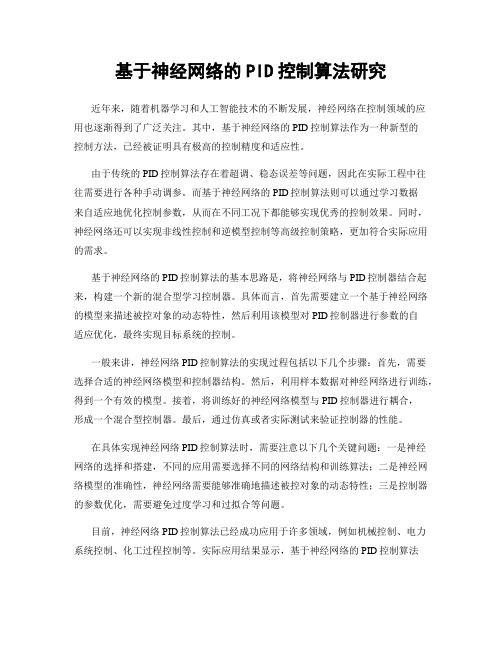
基于神经网络的PID控制算法研究近年来,随着机器学习和人工智能技术的不断发展,神经网络在控制领域的应用也逐渐得到了广泛关注。
其中,基于神经网络的PID控制算法作为一种新型的控制方法,已经被证明具有极高的控制精度和适应性。
由于传统的PID控制算法存在着超调、稳态误差等问题,因此在实际工程中往往需要进行各种手动调参。
而基于神经网络的PID控制算法则可以通过学习数据来自适应地优化控制参数,从而在不同工况下都能够实现优秀的控制效果。
同时,神经网络还可以实现非线性控制和逆模型控制等高级控制策略,更加符合实际应用的需求。
基于神经网络的PID控制算法的基本思路是,将神经网络与PID控制器结合起来,构建一个新的混合型学习控制器。
具体而言,首先需要建立一个基于神经网络的模型来描述被控对象的动态特性,然后利用该模型对PID控制器进行参数的自适应优化,最终实现目标系统的控制。
一般来讲,神经网络PID控制算法的实现过程包括以下几个步骤:首先,需要选择合适的神经网络模型和控制器结构。
然后,利用样本数据对神经网络进行训练,得到一个有效的模型。
接着,将训练好的神经网络模型与PID控制器进行耦合,形成一个混合型控制器。
最后,通过仿真或者实际测试来验证控制器的性能。
在具体实现神经网络PID控制算法时,需要注意以下几个关键问题:一是神经网络的选择和搭建,不同的应用需要选择不同的网络结构和训练算法;二是神经网络模型的准确性,神经网络需要能够准确地描述被控对象的动态特性;三是控制器的参数优化,需要避免过度学习和过拟合等问题。
目前,神经网络PID控制算法已经成功应用于许多领域,例如机械控制、电力系统控制、化工过程控制等。
实际应用结果显示,基于神经网络的PID控制算法相比传统PID控制算法,在控制精度、抗干扰能力、稳定性等方面都具有显著的优势,是一种极具应用前景的控制策略。
总的来说,基于神经网络的PID控制算法是一种结合了神经网络与PID控制器的混合型学习控制策略,具有优秀的控制精度和适应性。
基于神经网络的PID控制
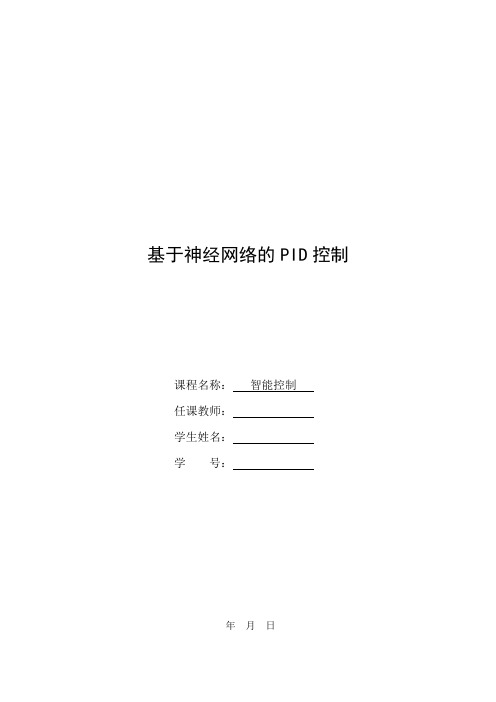
基于神经网络的PID控制课程名称:智能控制任课教师:学生姓名:学号:年月日摘要:本文基于BP神经网络的PID控制方法设计控制器,通过BP神经网络与PID的控制相结合的神经网络控制基本原理和设计来自适应的功能调节PID的的三个参数,并根据被控对象的近似数学模型来输出输入与输出并分析BP神经网络学习速率η,隐层节点数的选择原则及PID参数对控制效果的影响。
计算机的仿真结果表示,基于BP神经网络的PID控制较常规的PID控制具有更好的自适应性,能取得良好的的控制结果。
关键字:BP算法神经网络 PID控制Abstract:In this paper, based on BP neural network PID control method designed controller, through the BP neural network PID control with a combination of neural network control basic principles and design features adaptively adjusting the PID of the three parameters, and based on the controlled object approximate mathematical model to analyze the output and the input and output BP n eural network learning rate η, hidden layer nodes and PID parameter selection principle effect of the control . Computer simulation results indicated that based on BP neural network PID control compared with conventional PID control has better adaptability , can achieve good control results . Keyword:BP algorithms neural networks PID control1引言PID控制是最早发展起来的应用经典控制理论的控制策略之一,由于算法简单,鲁棒性好和可靠性高,被广泛应用于工业过程并取得了良好的控制效果。
基于BP神经网络的PID控制器设计【范本模板】

早在20世纪初,人们就已经发现人脑的工作方式与现在的计算机是不同的.人脑是由极大量基本单元(称之为神经元)经过复杂的相互连接而成的一种高度复杂的、非线性的、并行处理的信息处理系统。人工神经网络,是借鉴人脑的结构和特点,通过大量简单处理单元(神经元或节点)互连组成的大规模并行分布式信息处理和非线性动力学系统。它具有巨量并行性、结构可变性、高度非线性、自学习性和自组织性等特点.因此,它能解决常规信息处理方法难以解决或无法解决的问题,尤其是那些属于思维(形象思维)、推理及意识方面的问题从人脑的生理结构出发来研究人的智能行为,模拟人脑信息处理的过程,即人工神经网络的研究,自20世纪40年代以来,它的发展经历了一条由兴起、萧条和兴盛三个阶段构成的曲折道路。早在1943年精神病学家和神经解剖学家McCulloch与数学家Pitts在数学生物物理学会刊((Bulletin ofMathematical Biophysics))上发表文章,总结了生物神经元的一些基本生理特征,提出了形式神经元的数学描述与结构,即MP模型。他们的神经元模型假定遵循一种所谓“有或无"规则。如果如此简单的神经元数目足够多和适当设置突触连接并且同步操作,McCulloch和Pitts证明这样构成的网络原则上可以计算任何可计算函数。这是一个有重大意义的结果,有了它就标志着神经网络和人工智能学科的诞生。1958年,计算机科学家Rosenblatt提出感知机(Perceptron),首次把神经网络理论付诸工程实现。这是一种学习和自组织的心理学模型,它基本上符合神经生物学的知识,模型的学习环境是有噪声的,网络构造中存在随机连接,这是符合动物学习的自然环境。当时,人们对神经网络的研究过于乐观,认为只要将这种神经元互连成一个网络,就可以解决人脑思维的模型问题。但是,随之而来的Minsky和Papert(1969)所著的《Percepen》一书,利用数学证明单层感知器所能计算的根本局限,提出感知器的处理能力有限,甚至连XOR这样的问题也不能解决,并在多层感知器的总结章中,论述了单层感知器的所有局限性在多层感知器中是不可能被全部克服的。使人们降低了对神经网络研究的热情,从而使神经网络进入萧条时期[7]。但在其间,一些人工神经网络的先驱仍然致力于这一研究,美国波士顿大学的Crrossberg提出了自适应共谐振理论(ART网),芬兰的Kohonen提出了自组织映射(SOM),Amari致力于神经网络数学理论的研究,这些都为神经网络的进一步研究与发展奠定了基础.1986年Remelhart和Mcllelland等人提出了并行分布处理的理论,同时,Werbos和Parker独立发展了多层网络的BP算法,这是目前最普遍的网络,广泛用于实际问题求解。如今,神经网络的应用,已渗透到模式识别、图像处理、非线性优化、语音处理、自然语言理解、自动目标识别、机器人、专家系统等各个领域,并取得了令人瞩目的成果。从众多应用研究领域取得的丰硕成果来看,人工神经网络的发展具有强大的生命力。当前存在的问题是智能水平还不高,许多应用方面的要求还不能得到很好的满足:网络分析与综合的一些理论性问题(如稳定性、收敛性的分析,网络的结构综合等)还未得到很好的解决.随着人们对大脑信息处理机理认知的深化,以及人工神经网络智能水平的提高,人工神经网络必将在科学技术领域发挥更大的作用。
毕业设计(论文)_基于BP神经网络的PID控制器设计

(2)汽车行业。汽车自动驾驶系统、保险行为分析。
(3)银行业。支票和其他文档阅览器贷款评估器。
(4)国防领域。武器操纵控制、目标跟踪、物体识别、各种新的传感器。
(5)电子领域。编码序列预测、集成电路芯片的设计、过程控制芯片、故障分析、机器视觉声音合成、非线性建模。
(6)娱乐领域。动画、特效设计、市场预测。
阶跃响应是指将一个阶跃输入加到系统上时,系统的输出。稳态误差是指系统的响应进入稳态后,系统的期望输出与实际输出之差。控制系统的性能可以用稳、准、快三个字来描述。稳是指系统的稳定性,一个系统要能正常工作,首先必须是稳定的,从阶跃响应上看应该是收敛的;准是指控制系统的准确性、控制精度,通常用稳态误差来描述,它表示系统输出稳态值与期望值之差;快是指控制系统响应的快速性,通常用上升时间来定量描述。
在模拟控制系统中,控制器最常用的控制规律是PID控制。PID的控制规律为:
(2.1)
式中, —比例系数; —积分时间常数; —微分时间常数[4]。
比例控制是一种最简单的控制方式。其控制器的输出与输入误差信号成比例关系。当仅有比例控制时系统输出存在稳态误差。
基于神经网络的自适应PID控制策略研究
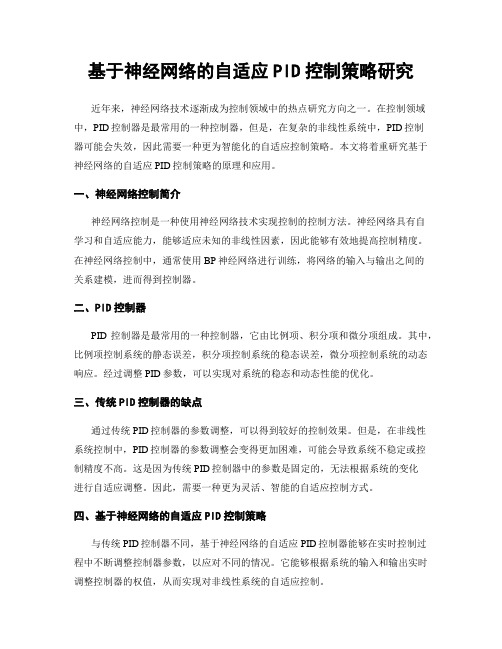
基于神经网络的自适应PID控制策略研究近年来,神经网络技术逐渐成为控制领域中的热点研究方向之一。
在控制领域中,PID控制器是最常用的一种控制器,但是,在复杂的非线性系统中,PID控制器可能会失效,因此需要一种更为智能化的自适应控制策略。
本文将着重研究基于神经网络的自适应PID控制策略的原理和应用。
一、神经网络控制简介神经网络控制是一种使用神经网络技术实现控制的控制方法。
神经网络具有自学习和自适应能力,能够适应未知的非线性因素,因此能够有效地提高控制精度。
在神经网络控制中,通常使用BP神经网络进行训练,将网络的输入与输出之间的关系建模,进而得到控制器。
二、PID控制器PID控制器是最常用的一种控制器,它由比例项、积分项和微分项组成。
其中,比例项控制系统的静态误差,积分项控制系统的稳态误差,微分项控制系统的动态响应。
经过调整PID参数,可以实现对系统的稳态和动态性能的优化。
三、传统PID控制器的缺点通过传统PID控制器的参数调整,可以得到较好的控制效果。
但是,在非线性系统控制中,PID控制器的参数调整会变得更加困难,可能会导致系统不稳定或控制精度不高。
这是因为传统PID控制器中的参数是固定的,无法根据系统的变化进行自适应调整。
因此,需要一种更为灵活、智能的自适应控制方式。
四、基于神经网络的自适应PID控制策略与传统PID控制器不同,基于神经网络的自适应PID控制器能够在实时控制过程中不断调整控制器参数,以应对不同的情况。
它能够根据系统的输入和输出实时调整控制器的权值,从而实现对非线性系统的自适应控制。
基于神经网络的自适应PID控制策略的实现方法,一般是将系统的输入和输出作为训练数据,通过训练得到神经网络的权值。
在控制器实时控制过程中,根据系统输出实时调整神经网络的权值,从而实现自适应控制。
五、应用实例基于神经网络的自适应PID控制策略在实际应用中,可以针对不同的场景进行多样化应用。
下面以一个灯光控制系统为例来进行说明。
基于神经网络的温度控制系统
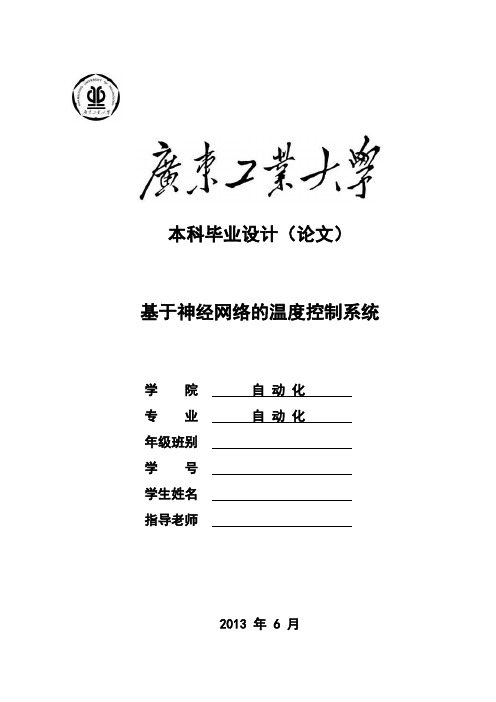
本科毕业设计(论文)基于神经网络的温度控制系统学院自动化专业自动化年级班别学号学生姓名指导老师2013 年 6 月摘要在工业控制过程中.PID控制是一种最基本的控制方式,其鲁棒性好、结构简单、易于实现,但随着生产工艺的日益复杂和人们对工业过程总体性能要求的不断提高,传统的PID控制方法往往难以满足闭环优化控制的要求。
因为常规PID控制器的参数是根据被控对象数学模型确定的.当被控对象的数学模型是变化的、非线性的时候,PID参数不易根据其实际的情况做出调整,影响了控制质量,使控制系统的控制品质下降。
特别是在具有纯滞后特性的工业过程中,常规的PID控制更难满足控制精度的要求。
而神经网络作为现代信息处理技术的一种,正在很多应用中显示了它的优越性,同传统的PID控制相比较,神经网络PID控制有许多优点。
神经网络PID控制技术在其中扮演了十分重要的角色,并且仍将成为未来研究与应用的重点技术之一。
本文阐述了神经网络PID控制算法的基本原理。
对基于单神经元的PID控制器的控制性能进行了分析,并且利用MATLAB/Simulink工具进行了仿真研究。
温度控制系统具有大滞后、强耦合、慢时变及非线性等特征的复杂系统。
在温度控制系统中,被控制对象存在着参数的不确定性和纯滞后等特性,难于建立其精确的数学模型,本文通过对受控对象温度控制系统的数字仿真研究,比较了传统PID控制与神经网络PID控制各自不同的控制特性,分析了传统PID控制器和神经网络PID控制器的优缺点。
并针对神经网络PID控制器的不足之处提出了相应的改进方案。
关键词:神经网络PID控制,数字仿真,Hebb算法,BP算法注:本设计(论文)题目来源于教师的国家级(或部级、省级、厅级、市级、校级、企业)科研项目,项目编号为:。
AbstractIn the process of industrial control. PID control is one of the most basic way of control, its good robustness, simple structure, easy to implement, but along with the increasing complexity of production process and constantly improve the overall performance requirements of industrial process, the traditional PID control method is often difficult to meet the requirements of the closed-loop optimal control. For conventional PID controller parameters are determined based on the mathematical model of the object. When the mathematical model of controlled object is variable, nonlinear, not easily according to the actual situation to adjust the PID parameters, the influence of quality control, the control quality of control system. Especially in the industrial process with pure lag properties, conventional PID control is more difficult to meet the requirements of control accuracy. And neural network as a kind of modern information processing technology, is a lot of applications shows its superiority, compared with the traditional PID control, the neural network PID control has many advantages. Neural network PID control technology played a very important role, and will continue to be one of the research and application of key technologies in the future.This paper expounds the basic principles of neural network PID control algorithm. Based on single neuron PID controller the control performance is analyzed, and the use of MATLAB/Simul ink tool has carried on the simulation research.Temperature control system with large lagging, strong coupling, time-varying and nonlinear characteristics of complex systems. In temperature control system, the controlled object parameter uncertainties exist and pure lag and so on characteristics, is difficult to establish accurate mathematical model, this paper research on the digital simulation of the temperature control system of controlled object, compares the traditional PID control and neural network PID control their different control features, analyzes the advantages and disadvantages of traditional PID controller and neural network PID controller. And in view of the deficiency of neural network PID controller is put forward the corresponding improvement plan.Key words:Neural PID Control,Digital simulation,Hebb Arithmetic,BP Arithmetic目录1 绪论 (1)1.1神经网络PID控制研究背景与动机 (1)1.2智能控制的发展概况 (2)1.3神经网络简介 (5)1.3.1 神经网络发展概述 (5)1.3.2 神经网络原理 (7)1.3.3 神经网络的分类 (12)1.3.4 神经网络的学习算法 (13)1.3.5 神经网络用于控制领域 (14)1.3.6 神经网络PID控制研究的意义和现状 (15)1.4 本文的主要内容 (17)2 神经网络PID控制器的实现 (18)2.1 基于神经网络的PID控制理论 (18)2.2 基于单神经元的PID控制 (19)2.2.1基于单神经元的PID控制器 (19)2.2.2单神经元PID控制器的稳定性分析 (23)3 基于Simulink的仿真研究 (24)3.1温度控制箱的数学建模 (24)3.2 传统PID控制器的设计与仿真 (26)3.2.1 PID控制算法 (26)3.2.2 数字PID控制器 (28)3.2.3常规PID控制器的局限性 (29)3.2.4温控箱基本PID控制器的数字设计与仿真 (29)3.3单神经元PID控制器的设计与仿真 (33)3.3.1单神经元PID控制系统的建立 (33)3.3.2单神经元PID控制系统的数字仿真 (34)4 结论与展望 (37)4.1工作总结 (37)4.2展望 (37)参考文献 (39)致谢 (41)1 绪论1.1神经网络PID控制研究背景与动机PID控制即比例、积分、微分控制。
BP神经网络在PID参数自整定中的应用

BP神经⽹络在PID参数⾃整定中的应⽤摘要摘要PID控制⽅法是经典控制算法中的典型代表,并在多种控制场合取得了很好的效果,但随着⽣产⼯艺的⽇益复杂和⼈们对⼯业过程总体性能要求的不断提⾼,被控对象越来越复杂,⼤量⾮线性控制对象的出现,传统的PID控制⽅法往往难以满⾜闭环优化控制的要求。
⽽神经⽹络作为现代信息处理技术的⼀种,正在很多应⽤中显⽰了它的优越性,神经⽹络PID控制技术在其中扮演了⼗分重要的⾓⾊,并且仍将成为未来研究与应⽤的重点技术之⼀。
本⽂阐述了神经⽹络PID控制算法的基本原理,并对⼏种典型的神经⽹络PID控制器的控制性能进⾏了分析。
关键词:神经⽹络;PID控制;Matlab仿真;梯度搜索算法;BP算法IABSTRACTABSTRACTThe PID control method is one of the traditional eontrol methods and gets good effects under many application situation.But with the increase in complexity of manufacture technics and demands of industrial process performance,the conventional PID control can not meet the requirement of closed loop optimized control.Neural network,as one of modern information proeess technologies,has some advantages in many application.Neural network PID control teehnology in which Plays a very imPortant role,and will become one of the focus of the research and application of teehnology.In this paper ,we describes the basic principles of neural network PID control arithmetic, and form the simulinks of Neural network PID controller,analyse their differences.Keywords:Neural Networks;PID Control;Matlab Simulation;Gradient Search Arithmetic;BP ArithmeticII⽬录第⼀章引⾔ (1)1.1神经⽹络PID控制器研究现状及发展态势 (1)1.2选题依据及意义 (1)1.3课题研究内容 (2)1.4课题的⽬标与拟解决的问题 (2)第⼆章⼈⼯神经⽹络 (3)2.1 ⼈⼯神经⽹络的发展 (3)2.2 ⽣物神经元 (4)2.3 ⼈⼯神经⽹络的结构 (5)2.3.1⼈⼯神经元及其激活函数 (6)2.3.2 神经⽹络的拓扑结构 (8)2.4 神经⽹络的学习 (10)2.4.1 神经⽹络的学习⽅式 (10)2.4.2 神经⽹络学习算法 (11)2.5神经⽹络的特点及其应⽤ (13)2.5.1 神经⽹络的特点 (13)2.5.2 神经⽹络的应⽤ (13)第三章传统PID控制 (14)3.1 传统PID控制简介 (14)3.2 数字PID控制算法 (15)3.3 PID控制的参数及其整定 (15)3.3.1 PID控制参数对性能的影响 (15)3.3.2 PID控制参数的整定 (16)3.4 传统PID控制的难题 (17)第四章BP神经⽹络PID控制器 (19)4.1 神经⽹络⽤于控制领域 (19)4.2 神经⽹络PID控制研究的意义与现状 (19)4.3 BP神经⽹络 (20)4.4 BP神经⽹络参数⾃整定PID控制器 (22)4.5 BP神经⽹络近似PID控制器 (26)III第五章BP神经⽹络PID控制器的编程与仿真 (29)5.1 编程语⾔Matlab语⾔简介 (29)5.2 BP神经⽹络⾃整定PID控制器的编程实现 (30)5.2.1参数初始化核⼼代码 (30)5.2.2 前馈计算核⼼代码 (30)5.2.3 误差反传核⼼代码 (31)5.3 BP神经⽹络⾃整定PID控制器的仿真 (32)5.4 BP神经⽹络近似PID控制器的编程实现 (38)5.5 BP神经⽹络近似PID控制器的仿真测试 (39)5.6 本章⼩结 (41)结束语 (42)参考⽂献 (43)致谢 (44)附录⼀:神经⾃整定PID控制器的M程序 (45)附录⼆:神经近似PID控制器的M程序 (48)外⽂资料原⽂ (51)外⽂资料译⽂ (54)IV第⼀章引⾔第⼀章引⾔1.1神经⽹络PID控制器研究现状及发展态势PID控制器从问世⾄今已经⼏⼗年了,成为⼯业过程控制中主要技术成功应⽤于机械冶⾦电⼒和轻⼯等⼯业过程控制领域中[1],对于PID控制器来说,要想得到较理想的控制效果,必须先对其三个参数:即⽐例系数( Kp ),微分系数( Ki ),微分系数( Kd )进⾏优化。
基于神经网络PID控制器的设计
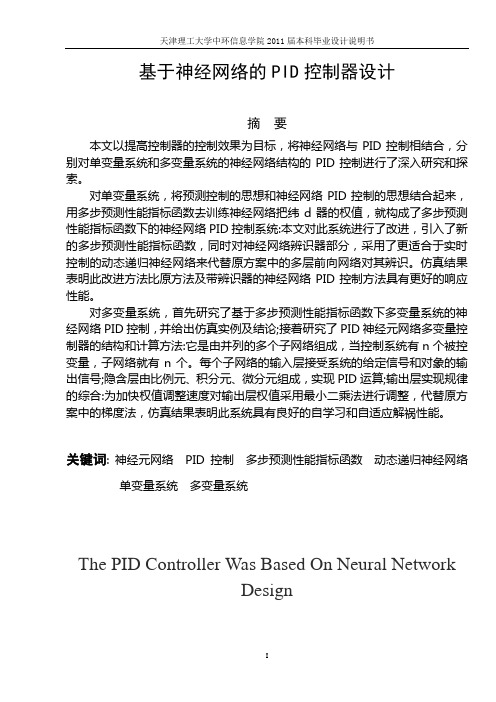
基于神经网络的PID控制器设计摘要本文以提高控制器的控制效果为目标,将神经网络与PID控制相结合,分别对单变量系统和多变量系统的神经网络结构的PID控制进行了深入研究和探索。
对单变量系统,将预测控制的思想和神经网络PID控制的思想结合起来,用多步预测性能指标函数去训练神经网络把纬d器的权值,就构成了多步预测性能指标函数下的神经网络PID控制系统:本文对此系统进行了改进,引入了新的多步预测性能指标函数,同时对神经网络辨识器部分,采用了更适合于实时控制的动态递归神经网络来代替原方案中的多层前向网络对其辨识。
仿真结果表明此改进方法比原方法及带辨识器的神经网络PID控制方法具有更好的响应性能。
对多变量系统,首先研究了基于多步预测性能指标函数下多变量系统的神经网络PID控制,并给出仿真实例及结论;接着研究了PID神经元网络多变量控制器的结构和计算方法:它是由并列的多个子网络组成,当控制系统有n个被控变量,子网络就有n个。
每个子网络的输入层接受系统的给定信号和对象的输出信号;隐含层由比例元、积分元、微分元组成,实现PID运算;输出层实现规律的综合:为加快权值调整速度对输出层权值采用最小二乘法进行调整,代替原方案中的梯度法,仿真结果表明此系统具有良好的自学习和自适应解祸性能。
关键词: 神经元网络 PID控制多步预测性能指标函数动态递归神经网络单变量系统多变量系统The PID Controller Was Based On Neural NetworkDesignABSTRACTIn order to enhance the performance of the controller, this paper combined the neural network and PID control, and deeply studied the neural network Pm controller based on single-variable and mufti-variable system.For single-variable system, the neural network PID controller based mufti-step predictive performance target function combined the predictive control idea and the neural network PID control idea. It uses multi-step predictive performance target function to train the weights of neural network PID controller, This paper improved the system: It uses new mufti-step predictive performance target function to train the weights, and it uses the dynamic recursion neural network instead of multiplayer feed forward neural network that is furthermore fit for real-time control to identify the part of neural network identification. The simulating results shows that this method has better response performance than the neural network PID control method with identificationFor mufti-variable systems, at first, This paper studied the neural networks PID controller based mufti-variable systems using mufti-step predictive performance target function, After studying the system's simulating instances, I got the results; Then this paper studied the structure and arithmetic of the PID neural network multivariable controller. It is made up of paratactic mufti-sub-network, if there are n controlled variables in controlling system, the sub-networks then will have n too. The input layer of each sub-network accepted the present signal of the system and the output signal of controlled object; The hidden layer that is made up of proportion, integral and differential three parts realizes PID operation; The output layer realizes the integration of the rules; and its output layer's weights were adjusted using the least mean squares in stead of grads arithmetic in order to quicken the regulative speed of the weights, the results show that the system has much higher performance of self-studying and self-adapting.Keywords: Neural network PID Control Multi-step predictive performance target function Dynamic recursion neural network Single-variable system Multivariable system目录第一章引言 (1)1.1 课题背景及研究意义 (1)1.2 课题当今的研究现状 (1)1.3 本文的结构组成 (2)第二章 PID控制器的基本原理 (3)2.1 PID控制器 (3)2.1.1 PID原理 (3)2.1.2 PID各参数的作用 (4)2.2 数字PID控制 (4)2.2.1 控制器的组成 (5)2.2.2 典型的PID控制器 (5)2.3 PID参数整定 (5)2.4 小结 (6)第三章神经网络的基本原理 (6)3.1 神经网络的模型结构 (7)3.2 几种典型的学习规则 (8)3.2.1 无监督的Hebb学习规则 (9)3.2.2 有监督的Delta学习规则 (9)3.3 几种典型的神经网络 (9)3.3.1 BP神经网络 (9)3.3.2 RBF 神经网络 (12)3.3.3 CMAC 神经网络 (14)3.4 小结 (16)第四章神经网络PID控制基本原理以及应用 (16)4.1 基于BP神经网络的PID控制 (17)4.1.1 BP神经网络整定原理 (17)4.1.2 MATLAB的背景和发展 (21)4.1.3 MATLAB的工作环境 (22)4.1.4 常规PID控制系统 (23)4.1.5 基于BP神经网络的PID控制系统 (24)4.2 RBF神经网络和CMAC神经网络PID控制 (30)4.2.1 RBF神经网络PID控制 (30)4.2.2 CMAC神经网络PID控制 (31)4.3小结 (31)第五章绪论 (32)参考文献 (33)致谢 (34)第一章引言1.1 课题背景及研究意义目前工业自动化水平已经成为了各行各业现代化水平的一个重要标志,而自动化的核心理论是控制理论。
神经网络PID毕业设计完整

摘要目前,由于PID具有结构简单,可通过调节比例积分和微分取得基本满意的控制性能,广泛应用在电厂的各种控制过程中。
电厂主汽温的被控对象是一个大惯性大迟延非线性且对象变化的系统。
常规汽温控制系统为串级PID控制或导前微分控制,当机组稳定运行时,一般能将主汽温控制在允许的范围内。
但当运行工况发生较大变化时,却很难保证控制品质。
因此本文研究BP神经网络的PID控制,利用神经网络的自学习、非线性和不依赖模型等特性实现PID参数的在线自整定,充分利用PID 和神经网络的优点。
本处用一个多层前向神经网络,采用反向传播算法依据控制要求实时输出Kp、Ki、Kd,依次作为PID控制器的实时参数,代替传统PID参数靠经验的人工整定和工程整定,以达到对大迟延主气温系统的良好控制。
对这样一个系统在MATLAB平台上进行仿真研究,,仿真结果表明基于BP神经网络的自整定PID控制具有良好的自适应能力和自学习能力,对大迟延和变对象的系统可取得良好的控制效果。
关键词:主汽温,PID,BP神经网络,MATLAB仿真ABSTRACTAt present, because PID has a simple structure and can be adjusted proportional integral and differential to satisfactory control performance,,it is widely used in power plants of various control process. The system of Power plant main steam temperature is an large inertia、big time-delayed and nonlinear dynamic system. Conventional steam temperature control system adopted cascade PID control or the differential control of lead before, when the unit is stable, general will allow the steam temperature control in the range ,but when operating conditions changed greatly, it is difficult to ensure the quality of control. This article studies PID control based BP neural network . Using such characteristics of neural network self-learning, nonlinear and don't rely on model realize PID parameters online auto-tuning. It can make full use of the advantages of PID and neural network. Here,we use a multilayer feedforward neural network using back propagation algorithm and based on control requirements.This net can real-time output Kp, Ki, Kd as the PID controller parameters ,insteading of the traditional PID parameters determined by experience. So it can obtain good control performance .For such a system ,we can simulate in MATLAB simulation platform.The simulation results show that the PID control based BP neural network has good adaptive ability and self-learning ability.For the system of large delay and free-model can obtain good control effect.KEY WORDS: main steam temperature ,PID ,BP neural network,MATLAB simulation目录摘要 (I)ABSTRACT (I)第一章绪论 (1)1.1 选题背景和意义 (1)1.2 国内外研究现状 (1)1.3 立论依据 (5)1.4 本文所做的主要工作 (5)1.5 本论文的章节安排 (5)第二章神经网络原理和应用 (7)2.1 MP模型 (7)2.2 神经网络的学习方式和学习规则 (8)2.2.1 神经网络的学习方式 (8)2.2.2 神经网络的学习规则 (8)2.3 神经网络的特点及应用 (9)2.4 BP神经网络 (10)2.4.1 BP神经网络的结构 (10)2.4.2 BP神经网络算法 (11)2.4.3 BP神经网络的前向传播算法 (11)2.4.4 BP神经网络的反向传播计算 (12)第三章基于BP神经网络的PID控制 (14)3.1 PID控制器的离散差分方程 (14)3.2 基于BP神经网络的PID整定原理 (15)3.3 基于BP网络的PID控制器控制的算法流程 (19)第四章基于BP神经网络的PID控制在主汽温控制系统中的应用 (23)4.1 锅炉主汽温的特点 (23)4.1.1 主汽温的控制任务 (23)4.1.2 主汽温控制对象的动态特性 (23)4.2 主汽温的数学模型 (25)4.2.1 主汽温控制系统调节信号的选择 (25)4.2.2 减温水扰动下主汽温的数学模型 (25)4.3 主汽温控制方法 (27)4.4 主汽温基于BP神经网络的PID控制Matlab仿真 (28)4.5 仿真结果分析 (37)结论与展望 (38)参考文献 (39)附录 A (41)致谢 (44)第一章绪论1.1 选题背景和意义在控制系统设计中,最主要而又最困难的问题是如何针对复杂、变化及具有不确定性的受控对象和环境作出有效的控制决策。
基于神经网络系统辨识PID控制的设计与仿真
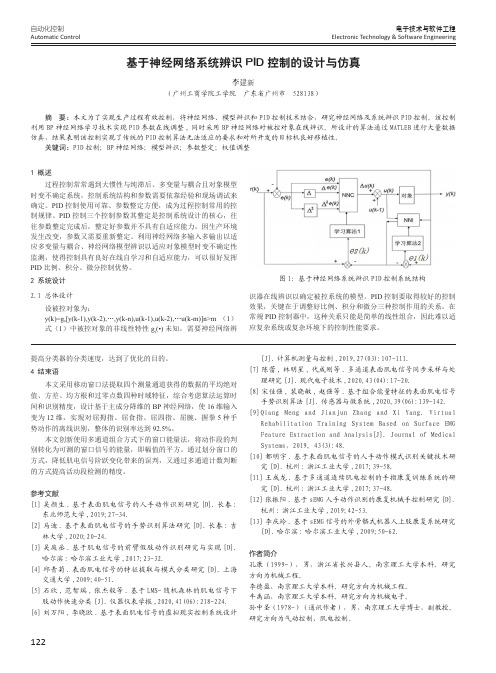
122自动化控制Automatic Control电子技术与软件工程Electronic Technology & Software Engineering1 概述过程控制常常遇到大惯性与纯滞后、多变量与耦合且对象模型时变不确定系统,控制系统结构和参数需要依靠经验和现场调试来确定。
PID 控制使用可靠、参数整定方便,成为过程控制常用的控制规律。
PID 控制三个控制参数其整定是控制系统设计的核心,往往参数整定完成后,整定好参数并不具有自适应能力,因生产环境发生改变,参数又需要重新整定。
利用神经网络多输入多输出以适应多变量与耦合、神经网络模型辨识以适应对象模型时变不确定性监测,使得控制具有良好在线自学习和自适应能力,可以很好发挥PID 比例、积分、微分控制优势。
2 系统设计2.1 总体设计设被控对象为:y(k)=g s [y(k-1),y(k-2),…,y(k-n),u(k-1),u(k-2),…u(k-m)]n>m (1)式(1)中被控对象的非线性特性g s (•)未知,需要神经网络辨基于神经网络系统辨识PID 控制的设计与仿真李建新(广州工商学院工学院 广东省广州市 528138)识器在线辨识以确定被控系统的模型。
PID 控制要取得较好的控制效果,关键在于调整好比例、积分和微分三种控制作用的关系。
在常规PID 控制器中,这种关系只能是简单的线性组合,因此难以适应复杂系统或复杂环境下的控制性能要求。
摘 要:本文为了实现生产过程有效控制,将神经网络、模型辨识和PID 控制技术结合,研究神经网络及系统辨识PID 控制。
该控制利用BP 神经网络学习技术实现PID 参数在线调整,同时采用BP 神经网络对被控对象在线辨识。
所设计的算法通过MATLEB 进行大量数据仿真,结果表明该控制实现了传统的PID控制算法无法适应的要求和对所开发的目标机良好移植性。
关键词:PID 控制;BP 神经网络;模型辨识;参数整定;权值调整图1:基于神经网络系统辨识PID 控制系统结构提高分类器的分类速度,达到了优化的目的。
神经网络PID控制系统的研究

神经网络PID控制系统的研究神经网络PID控制系统是一种将神经网络与PID控制策略相结合的控制方法。
这种控制系统在处理具有非线性、不确定性和时变性等特性的系统时具有显著的优势。
随着人工智能和自动化技术的不断发展,神经网络PID控制在工业过程控制、航空航天、机器人等领域的应用越来越广泛。
本文将介绍神经网络PID控制系统的研究背景、意义和现状,分析相关文献,并探讨未来的研究方向。
神经网络PID控制系统的研究始于20世纪90年代。
自那时以来,许多学者致力于研究神经网络PID控制系统的理论和实践。
其中,最具代表性的工作是利用神经网络对PID控制器的参数进行自适应调整。
例如,王占林等(2005)提出了一种基于神经网络的PID参数自适应控制器,用于解决传统PID控制器难以适应被控对象变化的问题。
该方法通过神经网络学习和调整PID控制器的参数,以提高控制系统的性能。
然而,他们的方法未能在复杂的实际应用场景中进行验证。
在另一方面,一些研究者于利用神经网络对PID控制器进行改进。
例如,赵春娜等(2007)提出了一种基于RBF神经网络的PID控制器,以解决传统PID控制器在处理非线性系统时的不足。
RBF神经网络具有较好的逼近能力和较低的计算复杂度,可以用于非线性系统的建模和控制。
然而,他们的方法需要选择适当的RBF神经网络结构和参数,这在实际应用中可能具有一定的挑战性。
本文提出了一种基于深度学习的神经网络PID控制系统。
我们通过数据采集和预处理,建立了被控系统的模型。
我们使用加速度传感器和角度传感器对机器人手臂进行了数据采集,包括位置、速度和加速度等参数。
然后,我们利用这些数据训练了一个深度神经网络模型,以实现对机器人手臂的高效控制。
在神经网络模型建立后,我们通过调整PID控制器的参数,实现了对传统PID控制器的优化。
具体地,我们利用神经网络的自适应学习能力,动态地调整PID控制器的Kp、Ki和Kd等参数。
这样,PID控制器可以根据实时数据自动调整其参数,以适应不同的运行条件和环境。
- 1、下载文档前请自行甄别文档内容的完整性,平台不提供额外的编辑、内容补充、找答案等附加服务。
- 2、"仅部分预览"的文档,不可在线预览部分如存在完整性等问题,可反馈申请退款(可完整预览的文档不适用该条件!)。
- 3、如文档侵犯您的权益,请联系客服反馈,我们会尽快为您处理(人工客服工作时间:9:00-18:30)。
ABSTRACT
At present, because PID has a simple structureand can be adjusted proportional integral and differential to satisfactory control performance,,it iswidely used in power plants of various control process.The system ofPower plant main steam temperature is anlarge inertia、bigtime-delayedand nonlinear dynamic system.Conventional steam temperature control system adopted cascade PID control or thedifferential control of lead before,when the unit is stable, general will allow the steam temperature control in the range,but when operating conditions changed greatly,itisdifficult to ensurethequality of control.This articlestudiesPID controlbased BP neural ing such characteristics of neural network self-learning, nonlinear and don't rely on model realize PID parameters online auto-tuning.Itcan make full use of the advantages of PID and neural network.Here,weuse amultilayer feedforwardneural networkusing back propagation algorithmandbased on control requirements.This net canreal-time output Kp, Ki, KdasthePID controller parameters,insteadingof the traditional PID parameters determined by experience.So it can obtain good control performance.For such a system,we can simulatein MATLAB simulation platform.The simulation results show that thePID control basedBP neural network has good adaptive ability and self-learning ability.For the system of large delay and free-model can obtain good control effect.
KEY WORDS:main steam temperature,PID,BP neural network,MATLABsimulation
第一章绪论பைடு நூலகம்
1.1
在控制系统设计中,最主要而又最困难的问题是如何针对复杂、变化及具有不确定性的受控对象和环境作出有效的控制决策。经典控制理论和现代控制理论的基础是建立数学模型,以此进行控制系统设计,然而面对工程实际问题和工程应用对控制要求的不断提高,基于数学模型的控制理论和方法的局限性日益明显。无模型控制能有效提高控制系统的适应性和鲁棒性,因此,走向无模型控制是自动控制发展的另一个重要方向。
在1943年,麦卡洛克和皮茨首次提出了脑模型,其最初动机在于模仿生物的神经系统。随着超大规模集成电路(VLSl)、光电子学和计算机技术的发展,人工神经网络(ANN)己引起更为广泛的注意。近年来,基于神经元控制的理论和机理已获得进一步的开发和应用。尽管基于神经元的控制能力还比较有限,但由于神经网络控制器具有学习能力和记忆能力、概括能力、并行处理能力、容错能力等重要特性,仍然有许多基于ANN的控制器被设计出来,这类控制器具有并行处理、执行速度快、鲁棒性好、自适应性强和适于应用等优点,广泛的应用在控制领域[1]。
神经网络控制是一种基本上不依赖于模型的控制方法,它比较适用于那些具有不确定性或高度非线性的控制对象,并具有较强的适应和学习功能,它是智能控制的一个重要分支。对于自动控制来说,神经网络有具有自适应功能,泛化功能,非线性映射功,高度并行处理功能等几方面优势〔2〕,这使得神经网络成为当今一个非常热门的交叉学科, 广泛应用在电力,化工,机械等各行各业,并取得了比较好的控制效果。
摘要
目前,由于PID具有结构简单,可通过调节比例积分和微分取得基本满意的控制性能,广泛应用在电厂的各种控制过程中。电厂主汽温的被控对象是一个大惯性大迟延非线性且对象变化的系统。常规汽温控制系统为串级PID控制或导前微分控制,当机组稳定运行时,一般能将主汽温控制在允许的范围内。但当运行工况发生较大变化时,却很难保证控制品质。因此本文研究BP神经网络的PID控制,利用神经网络的自学习、非线性和不依赖模型等特性实现PID参数的在线自整定,充分利用PID和神经网络的优点。本处用一个多层前向神经网络,采用反向传播算法依据控制要求实时输出Kp、Ki、Kd,依次作为PID控制器的实时参数,代替传统PID参数靠经验的人工整定和工程整定,以达到对大迟延主气温系统的良好控制。对这样一个系统在MATLAB平台上进行仿真研究,,仿真结果表明基于BP神经网络的自整定PID控制具有良好的自适应能力和自学习能力,对大迟延和变对象的系统可取得良好的控制效果。
